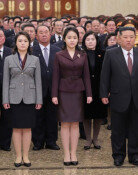A New 2+4 System for the College of Pharmacy
A New 2+4 System for the College of Pharmacy
Posted April. 08, 2005 23:35,
The current system, in which a college of pharmacy is four years long, could be replaced with the 2+4 system, in which students complete two years in the science department of their university and then enter the college of pharmacy for another four years.
A research group for the improvement of the college of pharmacy, which studied the reform of the system of the college of pharmacy at the request of the Ministry of Education and Human Resources Development (MOE), submitted its education process for training pharmacists and plan for educational system report to the MOE on April 7, which includes a measure to reorganize the college of pharmacy to the 2+4 system, after putting the relevant groups opinion together,.
An official of the research group said that its necessary to transform the current system in order to establish the structure of fostering specialized people in higher education, adding that among alternative plans of 2+4, 4+4, and the six-year-long systems, the 2+4 system is most practical, but still needs to be coordinated with the MOE and other groups involved.
The research groups plan seems to have accommodated the claims by the Korean Pharmaceutical Association (KPA) and the Ministry of Health and Welfare (MOHW) that the existing four-year-long college of pharmacy, which fails to let students learn enough theory and practice, lacks to nurture elite pharmacists and the position of the Korean Medical Association (KMA) that opposes a six-year-long program.
If the system of colleges of pharmacy changes to a 2+4 system, students, who learn basic science subjects for two years, will take the Pharmacy College Admission Test (PCAT) and will enter the college of pharmacy for another four-year study.
It appears that regardless of the existence of colleges of pharmacy, the students who complete the early required subjects necessary for pharmaceutical study in their science department could apply to take the PCAT.
The research team stated that in order to reorganize the system, the Higher Education Law should be revised, and that the education process for training pharmacists and the state examination for pharmacists should be improved.
The team further stated that if the 2+4 system were introduced in 2007, a college of pharmacy wouldnt select new students for two years and that it would select first-year students under the new system starting in 2009.
There are some indications that although a total of 20 universities currently have pharmaceutical departments, with the exception of a few schools, most universities have a 20:1 professor to student ratio, and do not utilize a wide range of education processes.
However, it is expected that the universities and the KMA will resist the 2+4 plan, which would cause the MOE to face difficulties in drawing final measures.
In particular, students in the science department pointed out that the 2+4 plan would deepen the shrinking of pure studies, making students drop their original departments, in pursuit of the college of pharmacy.
An official of the KMA remarked that around 95 percent of current pharmacists started practice, that the rate of advancement into the graduate school of pharmacy stands at a mere five percent, and that excessive extending the current system could impose a burden on the public, including the rise in drug costs.
However, some people indicate that the real reason why the KMA opposes the 2+4 system is because they fear that they might lose control over drug costs, which has been in their purview so far through the Drug Utilization Review Committee (DUR), if pharmacists become more specialized.
In-Chul Lee inchul@donga.com




![전기매트 틀고 자면 몸에 전자파 쌓인다?” 직접 측정해보니 [알쓸톡]](https://dimg.donga.com/c/138/175/90/1/wps/NEWS/IMAGE/2026/01/02/133079758.3.jpg)


